Digital Approaches to Film Aesthetics: Computer-based Analysis and Expressive Movement
15./16.12.2020 | Digital workshop by the Cinepoetics group with Yuri Tsivian, Daria Khitrova and Barbara Flückiger.
Research Focus: Digital Material and Essayistic Method
The workshop focused on the potential of digital methods for the qualitative analysis of audiovisual media. Based on the theoretical and methodological framework of expressive movement and combined with quantitative methods, the presentations expounded how digital tools can be used in qualitative dimensions of audiovisual meaning-making.
In his presentation "Climate Projections and World Projections," Matthias Grotkopp explored the use of digital tools for comparing and evaluating processes of meaning-making, using examples from An Inconvenient Truth (USA 2006, Davis Guggenheim), The Age of Stupid (UK 2009, Fanny Armstrong) and a commercial by BSR (D 2015, Trenntstadt Berlin/BSR).
Within the theoretical framework of expressive movement analysis, Grotkopp first showed how variations and repetitions of the same motif in An Inconvenient Truth construct an experience of evidence, while staging tools like color, language, and movement create an increased sense of change. A close analysis of the visual movement patterns in The Age of Stupid revealed how different forms of temporality and figuration establish a sense of time escaping and accelerating, thus constituting a temporal gestalt. Using the video-annotation software Advene developed within the project "Audio-visual Rhetorics of Affect," Grotkopp showed how a commercial by BSR (Berlin Waste Management) constructs a disintegrating planet that suddenly restabilizes and related it to other cinematic world projections. In closing, Grotkopp commented on how the concept of expressive movement combined with digital tools allows for the empirical and intersubjectively comparable qualitative analysis of audiovisual meaning-making.
Yuri Tsivian and Daria Khitrova gave two interrelated talks, which focused on the analysis of expressive movement and montage with tools developed in their digital-humanities project "Cinemetrics." While Tsivian focused on the works of D.W. Griffith, Khitrova elaborated on Charlie Chaplin's films with regard to Cinemetrics analyses.
The overarching question that Tsivian proposed concerned the relation between editing tempo and affective impact. His talk began with a presentation of "Cinemetrics" and its tools for measuring, visualizing, and comparing quantitative elements of films. The open-source software and online database allow the tracing and statistical analysis of changes in film editing from a film historical perspective. As early as the mid-1910s, numerical counting methods were used to evaluate films regarding their emotional effect on viewers. However, these studies focused solely on the average shot length and did not consider fluctuations within films. Taking a closer look at D.W. Griffith, Tsivian showed that the director was highly aware of how the editing rhythm would influence the spectator's emotions and varied the shot length according to dramatic climaxes. Moreover, Griffith tied the film's rhythm to the viewer’s bodily experience and used the human heartbeat as a measure to compare cultural differences. Tsivian confirmed the director's theoretical propositions by visualizing Griffith’s projected ideal film’s rhythm, which resulted in a pulse-like curve of different speeds.
Daria Khitrova's presentation focused on the interrelation of acting and editing in Chaplin's films. Slapstick comedies produced by Keystone studios used a technique that she calls "cross-acting," meaning that physical interactions are performed across one or more cuts. With this method, cutting speed could be increased to heighten excitement in the audience. Thus, the acting style followed the editing technique. Furthermore, Khitrova cited a correlation between the editing tempo and the number of actors in the frame. In Chaplin's films, the gags could be anticipated by the audience without giving away the joke, as long as the character is unaware of the action about to happen. Khitrova showed that shots with Chaplin alone or absent would be cut faster than when interacting with other characters or even objects. This principle was later described by theorist Victor Shklovsky, stating that narrative is built by obstacles that delay or decelerate the action. Khitrova concluded that the interaction with people or objects would serve as a delaying factor for Chaplin, thus equating acting and interacting.
The second day started with Jan-Hendrik Bakels' presentation on "Ebb, Flow, and Failing Dams – A Digital Analysis of Aesthetics and Rhetorics in Michael Moore's Capitalism – A Love Story." He outlined the genesis of the project "Audio-visual Rhetorics of Affect" by introducing various manual annotation methods. Focusing on Eisenstein's notion of musicality and montage, he presented his own annotation work with regard to Nicolas Winding-Refn's Drive (USA 2011). In comparing shot size, camera movement, and frequency of montage, Bakels worked out the variation of motifs on the micro-level. For the analysis of Michael Moore's film, he then turned to digital annotation tools and the possibility to switch between micro and macro levels when comparing motifs. The ebb-and-flow-rhetoric in Capitalism – A Love Story becomes graspable within the limits of a single sequence as well as in the whole timeline of the film, as Bakels' annotations showed. Thus, this movement may re-evaluate Eisenstein’s notion in the realm of the digital.
To conclude the two-day workshop, Barbara Flückiger introduced a wide range of digital tools to analyzse film colors. Her presentation "Color and Expressive Movement. A Computer-assisted Analysis" elaborated on the possibility of incorporating expressive movement analysis in working with film color annotation in ELAN as well as the Zürich-based project VIAN. Flückiger exemplified how the analysis of stylistic, expressive, and narrative dimensions functions when thinking about the annotation itself as well as its usability when gathering individual findings in large databases. Among various other examples, Luchino Visconti's Morte a Venezia (I 1971) underlined the challenges of automatic annotation processes regarding cluttered or multi-layered image composition. While laying the groundwork for automatic annotation and tagging work, Flückiger also identified theoretically sound reasoning and constant reflection on visualization methods as mandatory requirements for the interdisciplinary collaboration between film studies and computer science.
